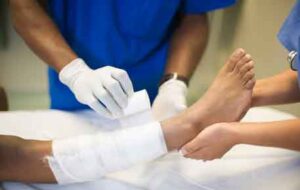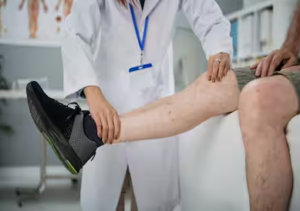Peripheral Arterial Disease: Why Your Podiatrist Cares About Your Circulation
September 17 2025
Did you know your feet can reveal life-saving clues about your health? Learn why Peripheral Arterial Disease (P.A,D.) is more than a foot issue – and how your podiatrist can help keep you moving! #Foot
health #PADAwareness #HealthyLiving #FFLC
Lori DeBlasi
Kevin Lam, DPM, FACFAS
Your feet are more than what keeps you moving – they can reveal important clues about your overall health. One serious condition that often starts showing signs in the feet is Peripheral Arterial Disease (P.A.D.) This condition occurs when plaque – made up of fat, cholesterol, and other substances – builds up in the arteries and reduces blood flow to your legs and feet.
When blood flow is restricted, the tissues in your feet don’t receive enough oxygen and nutrients. Over time, this can cause pain, slow-healing wounds, infections, and in severe cases, amputation. What’s even more alarming is that P.A.D. doesn’t just affect your legs – it’s a strong warning sign for heart disease is stroke.
Unfortunately, many people are unaware they have P.A.D. until it’s advanced. That’s why podiatrists play a critical role in early detection and management. We often see the early warning signs during a routine foot exam, sometimes before patients even realize something is wrong.
Who is Most at Risk – and Why it Matters
- Diabetes
- Smoking
- High blood pressure
- High cholesterol
- Obesity
- Age over 50
If you have any of these risk factors, your chances of developing circulation issues are much higher. For example, people with diabetes are particularly vulnerable because high blood sugar levels can damage blood vessels over time, worsening the narrowing of arteries. Smokers are also at an extremely high risk because smoking directly damages the blood vessel walls and accelerates plaque buildup.
Early Warning Signs You Shouldn’t Ignore
One reason P.A.D. can be so dangerous is that its symptoms often mimic other conditions or are dismissed as “just getting older”. Here are a few common signs that could indicate trouble with your circulation:
dismissed as “just getting older”. Here are a few common signs that could indicate trouble with your circulation:
- Leg pain when walking that goes away with rest (claudication)
- Cold feet or toes or one foot that feels colder than the other
- Slow-healing wounds or sores on the feet
- Changes in the color of your skin or toenails
If you notice any of these symptoms – even occasionally – don’t ignore them. They may be your body’s way of telling you that blood flow is compromised, and that needs immediate attention.
Why Podiatrists Often Catch P.A.D. First
Here’s the truth: many people see their podiatrist more often than their primary care doctor, especially if they have diabetes, foot pain, especially if they have diabetes, foot pain, or chronic foot problems. This puts podiatrists in a unique position to spot early circulation issues before they become severe,
During a foot exam, we look for signs like weak or absent pulses, temperature differences between the feet, color changes, and wounds that aren’t healing properly. If something raises a red flag, we may perform a quick non-invasive vascular test called an Ankle-Brachial Index (ABI) or refer you to a vascular specialist for further evaluation.
Why does early detection matter so much?
Because P.A.D. is progressive. The longer it goes untreated, the greater the risk of serious complications – including limb loss and life-threatening cardiovascular events.
Treatment and Daily Care
The good news is that with the right approach, P.A.D. can be managed. Treatment focuses on improving blood flow and reducing the risk of complications. This usually involves lifestyle changes such as quitting smoking, exercising regularly, eating a heart0healthy diet, and managing blood pressure, cholesterol, and blood sugar levels.
improving blood flow and reducing the risk of complications. This usually involves lifestyle changes such as quitting smoking, exercising regularly, eating a heart0healthy diet, and managing blood pressure, cholesterol, and blood sugar levels.
Medications may be prescribed to control these risk factors, and in advanced cases, vascular specialists can perform procedures like angioplasty or bypass surgery to restore blood flow.
From a podiatry perspective, foot care is absolutely essential. People with P.A.D. need to check their feet daily for cuts, blisters, or color changes. Even a small wound can become infected quickly when circulation is poor. Wearing proper footwear, keeping your skin moisturized, and seeking prompt care for any injuries can make a huge difference in preventing serious complications.
A Real-life Example that Proves the Point
I’ll never forget a patient who came to see me for what seemed like a routine ingrown toenail. During the exam, I noticed his foot was cooler than normal and the toenails were discolored. That raised a red flag, so I ordered a vascular study. It turned out he had advanced P.A.D. and was at high risk for losing his leg. Because we caught it early, he received the right treatment and avoided amputation.
That case reminded me why podiatric care is about so much more than foot comfort – it can literally save lives.
What You can do Now
If you have any risk factors or notice warning signs, the best step you can take is to schedule a comprehensive foot exam with your podiatrist. Between visits, check your feet daily, avoid smoking, and keep moving – low-impact exercises like walking can significantly improve circulation over time.
Small steps can make a big difference in your health and mobility.
The Bottom Line
Peripheral Arterial Disease is not jut a foot problem – it’s a serious health condition that affects your  whole body. Left untreated, it can lead to devastating consequences. But when detected early and managed properly, you can protect your feet, maintain your independence, and live a healthier life.
whole body. Left untreated, it can lead to devastating consequences. But when detected early and managed properly, you can protect your feet, maintain your independence, and live a healthier life.
Your podiatrist is your partner in this journey. Don’t wait for symptoms to get worse – your feet may be trying to tell you something important.
If you have symptoms of Peripheral Arterial Disease, contact Dr, Deblasi’s office at (239) 430-3668 (FOOT) or schedule online at www.NaplesPodiatrist.com.
Serving Southwest Florida Since 2005, Family Foot & Leg Center has multiple convenient locations throughout Collier, Lee, Charlotte, and Sarasota Counties. Offering pediatric to geriatric family care: Ingrown Toenails, Heel Pain, Bunions, Foot / Ankle Arthritis Pain, Plantar Fasciitis, Foot / Ankle Surgery, Custom Orthotics, and Diabetic Wound Care. In office X-rays, ultrasounds, and minor surgical suite exam rooms. Practice powered by EMR and advanced technologies.
Home of the Lam Minimally Invasive No-Scar Bunion Surgery! Come Discover Why Patients Love Our 5-Star Foot & Ankle Care!
For advanced wound management and diabetic wound healing resources, visit:
👉 WoundHealingExperts.com
Same Day Appointments! Easy Online Appointment Scheduling.

 Fax: (239) 692-9436
Fax: (239) 692-9436 Tel: 239-430-3668
Tel: 239-430-3668